Russians keep fruit in vodka for both practical and cultural reasons dating back to the 1400s. You'll find this preservation method deeply rooted in Russian hospitality and national pride, originally used to mask impurities in early vodka production. The high alcohol content (40%) naturally preserves fruits while creating flavorful infusions that play important roles in celebrations, weddings, and family gatherings. This tradition isn't just about preservation – it's about creating unique flavors and maintaining cultural identity. From monasteries to modern kitchens, the art of vodka infusion continues to evolve while honoring centuries of Russian ingenuity and craftsmanship.
Historical Origins of Vodka Preservation
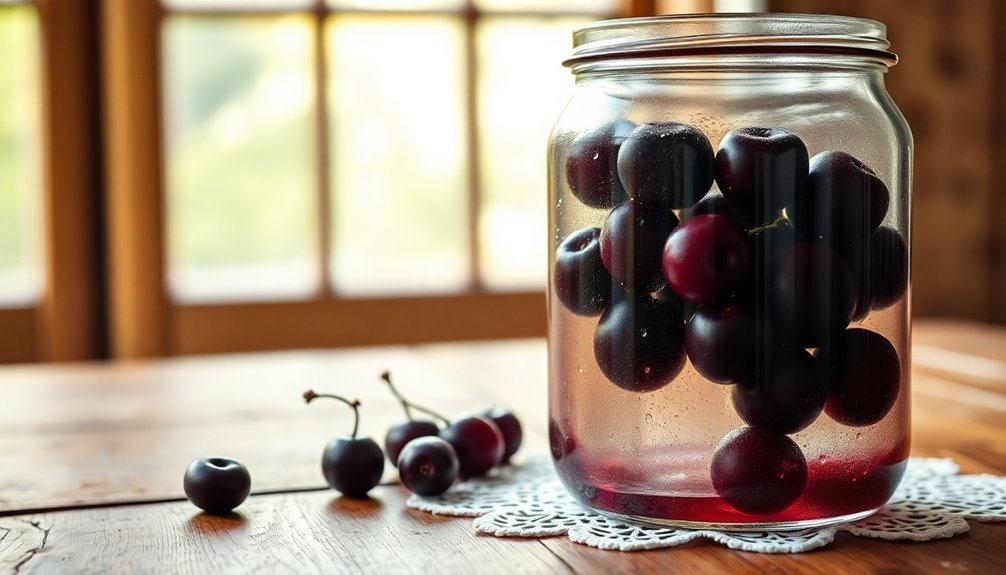
In accordance with Russian tradition, the practice of preserving fruit in vodka traces its roots back to the early 1400s when vodka production first emerged in Russia.
You'll find that this preservation method developed alongside the evolution of distillation techniques, which were initially introduced by Genoese merchants and later refined by Russian monasteries.
During these early days, you'd notice that vodka wasn't as pure as it's today. The crude distillation processes left impurities that needed masking, which led to the common practice of adding fruits and other flavoring agents. The establishment of a Russian state monopoly in 1553 helped standardize these preservation practices across the nation.
This necessity eventually transformed into a cherished tradition that served multiple purposes. Not only did the fruit help improve the taste, but the vodka also acted as an excellent preservative for the fruit itself.
When you look at the historical records, you'll see that monasteries played an essential role in developing these preservation techniques. Monks like Isidore of the Chudov Monastery experimented with various ingredients and methods, creating recipes that would be passed down through generations.
Even as distillation techniques improved with innovations like charcoal filtering in the 1700s, the tradition of infusing fruits in vodka remained deeply embedded in Russian culture.
Cultural Significance in Russian Tradition
You'll find that infusing vodka with fruit isn't just about preservation – it's a cherished Russian tradition that strengthens social bonds and cultural identity.
The practice represents Russian ingenuity and resourcefulness, appearing prominently in literature, celebrations, and everyday gatherings as a symbol of hospitality and national pride. The tradition dates back to the 14th century origins when vodka first became an integral part of Russian society.
Whether it's a wedding toast or a family recipe passed down through generations, fruit-infused vodka continues to play an essential role in connecting Russians to their heritage and traditions.
Historical Vodka Preservation Methods
Russia's rich vodka-making tradition dates back to the 14th century, with monasteries playing an essential role in developing early preservation methods.
You'll find that monks like Isidor were among the first to perfect vodka distillation techniques, initially creating the spirit for medicinal purposes in the Kremlin monasteries between 1448 and 1478.
The preservation process evolved considerably over time, incorporating various filtration methods that you'd recognize as the foundation for modern vodka production.
You'll see how they used raw wood charcoal in copper filters, which remained the standard until 1924, when activated carbon revolutionized the process by reducing filtration time from 24 hours to just 30 minutes.
Noble households in the 18th century took preservation further by implementing sophisticated techniques like using fresh milk, cream, and even freezing to purify their vodka.
The discovery of charcoal filtration by Toviy Yegorovich Lowitz in 1785 marked a significant advancement in vodka preservation and purification.
You'll notice that traditional preservation often included adding natural preservatives through infusion, such as honey, pepper, and juniper berries.
These additives didn't just enhance flavor – they helped maintain the vodka's quality during storage, especially when it was sold in large 12.3-liter quantities.
Cultural Heritage And Identity
Beyond its preservation methods, vodka stands as a cornerstone of Russian cultural identity and hospitality. You'll find it at the heart of traditional ceremonies, from weddings to promotions, where it serves as a symbol of national pride and communal bonding.
When you participate in Russian celebrations, you'll notice how vodka-based toasts mark significant moments, strengthening social connections and cultural ties.
The practice of infusing vodka with fruits and berries reflects Russia's deep connection to its land and heritage. You're not just tasting a beverage; you're experiencing centuries of tradition that emphasize sustainability and regional ingredients.
This cultural significance extends beyond vodka to other traditional drinks like kvass, kompot, and mors, which you'll find served everywhere from homes to street kiosks.
When you encounter fruit-infused vodka at Russian gatherings, you're participating in a tradition that bridges past and present. It's a practice that showcases Russian ingenuity and resilience, celebrated in literature, film, and folk songs.
These drinks aren't just refreshments; they're living representations of Russia's enduring customs and cultural identity.
Chemistry Behind Alcohol Preservation
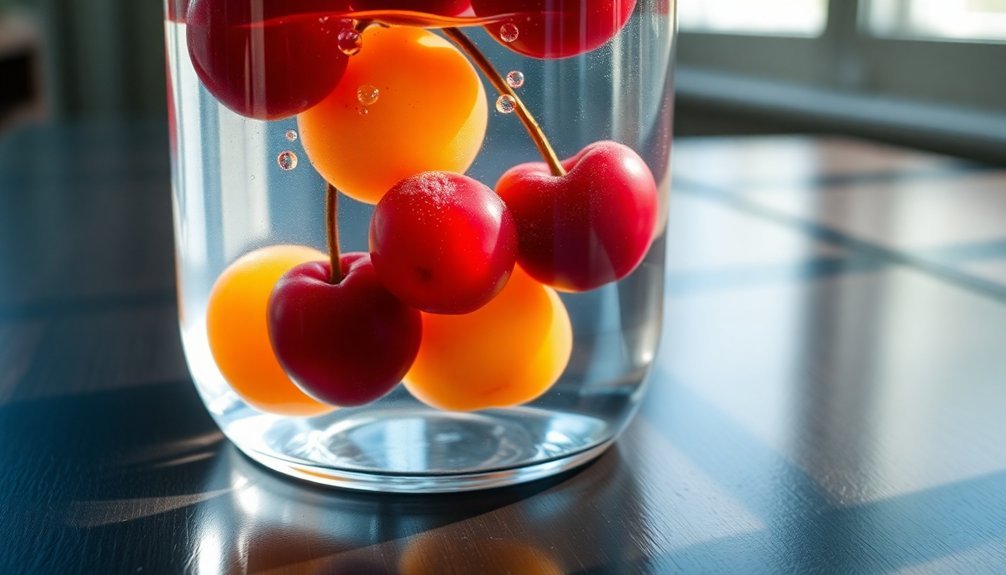
Understanding the chemistry of alcohol preservation reveals why vodka serves as an effective medium for storing fruit. The high ethanol concentration in vodka (typically 40% v/v) creates an environment where harmful microorganisms can't thrive, effectively preventing spoilage and decay.
You'll find that vodka's preservation power comes from its ability to disrupt microbial cell membranes while maintaining the fruit's structural integrity.
When you store fruit in vodka, several chemical processes occur that help preserve and enhance the produce:
- The ethanol molecules penetrate the fruit's surface, triggering enzymes like alcohol dehydrogenase and pyruvate decarboxylase that help stabilize the tissue.
- The alcohol maintains fruit firmness by slowing down natural degradation processes.
- Soluble solids content and titratable acidity increase, contributing to enhanced flavor profiles.
- New flavor compounds form as the alcohol interacts with fruit components, creating distinctive esters.
You're not just preserving the fruit – you're initiating a complex chemical transformation. The vodka acts as both preservative and flavor extractor, creating an environment where the fruit's qualities are maintained while new, pleasant taste compounds develop over time.
Selecting The Right Fruit
Selecting the right fruit stands as the cornerstone of successful vodka infusion. You'll want to choose fruits that are perfectly ripe or even slightly overripe, as they'll release more intense and desirable flavors into your vodka. This practice also helps prevent food waste by utilizing fruits before they spoil.
You've got plenty of options when it comes to fruit selection. Berries offer vibrant colors and sweet-tart profiles, while citrus fruits add zesty brightness. You can experiment with strawberries, cranberries, or even tropical fruits like pineapple and coconut. Each fruit brings its unique characteristics to the infusion process.
You'll need to take into account how different fruits behave during infusion. Berries break down quickly, so you should remove them after a few days. When strawberries turn white, it's time to take them out. Citrus fruits are hardier and can steep longer, while cranberries might need a few pokes with a toothpick to release their flavors.
If you're feeling adventurous, you can enhance your fruit infusions with complementary spices and herbs. Try adding cinnamon sticks, mint leaves, or even red pepper for unique flavor combinations that'll make your infused vodka stand out.
Essential Equipment and Materials
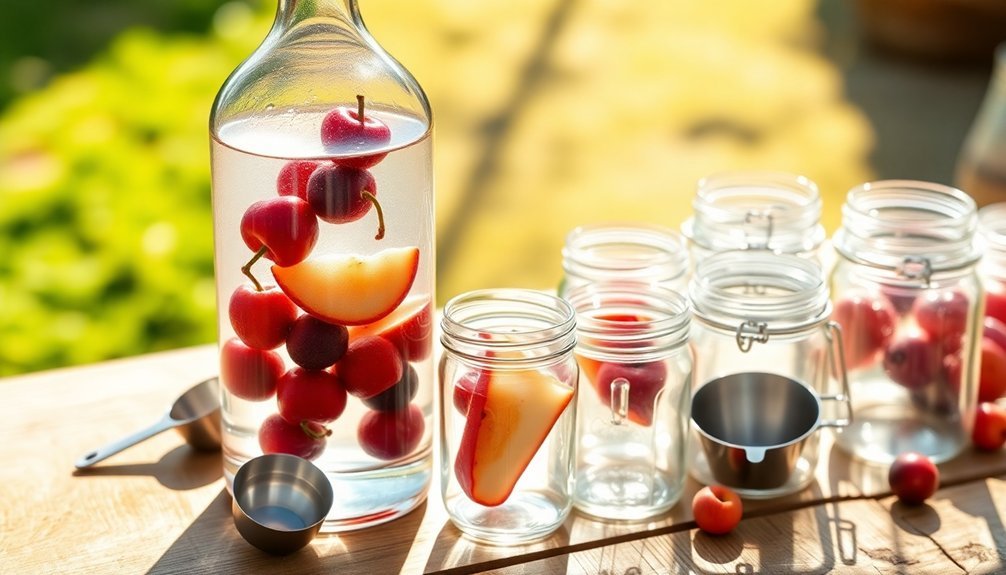
You'll need clean glass containers with tight-fitting lids to properly store your fruit-infused vodka and prevent any contamination during the steeping process.
A good set of measuring cups and spoons helps you maintain consistent proportions of fruit, sugar, and alcohol in your infusions.
The quality of your vodka matters considerably, so select a mid-range to premium vodka that's smooth and neutral in flavor, as it will serve as the foundation for your fruit-flavored spirit.
Clean Glass Storage Containers
The proper glass storage container serves as the foundation for creating fruit-infused vodka. When choosing your vessel, opt for quart-size glass jars or vintage canning jars that provide enough space for both fruit and vodka. Mason jars and ceramic crocks work excellently too, as long as they're non-porous and can be sealed tightly.
Before you begin the infusion process, it's essential to properly prepare your containers. While the high alcohol content in vodka makes sterilization not absolutely necessary, it's still recommended to take these precautionary steps:
- Clean your containers thoroughly with bleach or Star-San solution, or sterilize them by boiling.
- Confirm all parts of the container, including the lid, are completely dry.
- Check that your chosen container has an airtight seal to prevent vodka evaporation.
- Verify the container is large enough to accommodate both fruit and vodka with some headspace.
When storing your infusion, keep the containers away from direct sunlight and heat. Place them in a cool, dark location, and always make sure they're sealed tightly.
This careful attention to your storage containers will help guarantee a successful fruit infusion process.
Basic Measuring Tools
Proper measuring tools form the backbone of successful fruit-infused vodka making.
You'll need a reliable measuring cup to guarantee you're using the correct proportions of vodka for your fruit infusions. A high-quality knife and chopping board are essential for preparing your fruits uniformly, which helps achieve consistent flavor extraction during the infusion process.
Don't overlook the importance of a small funnel, as it'll help you transfer your vodka mixture without spills or waste. When working with smaller batches, this tool becomes particularly valuable for precise pouring into narrow-necked bottles.
You'll also want to keep a wooden spoon handy for occasional stirring and muddling of softer fruits to release their essential oils and juices.
For accurate measurements and proper preparation, you should consider investing in a complete set of measuring cups rather than relying on estimations.
When you're working with expensive vodka and fresh fruits, precise measurements can make the difference between a perfectly balanced infusion and an overpowering or weak result.
These basic tools will help you maintain consistency in your recipes and achieve reliable results every time.
Quality Vodka Selection
Selecting high-quality vodka serves as your foundation for successful fruit infusions. When choosing your base vodka, you'll want to focus on products that have undergone proper distillation and filtering processes, using quality equipment like still columns and charcoal filters. The right vodka will have a clean, neutral taste that won't overshadow your fruit flavors.
You can identify quality vodka by examining these key factors:
- Check for clarity – premium vodka should be crystal clear without any particles or cloudiness, indicating proper filtration through materials like charcoal or coffee filters.
- Verify the alcohol content – quality vodka typically maintains a consistent 40% ABV (80 proof), which you can measure using a hydrometer.
- Assess the aroma – high-quality vodka should have minimal smell, suggesting proper distillation using professional equipment like copper-packed stills.
- Test the taste – quality vodka offers a clean finish without harsh burning, reflecting proper water ratios and careful temperature control during production.
Don't skimp on your base spirit – using inferior vodka can compromise your entire infusion project, regardless of the quality of fruit you'll be adding later.
Step by Step Preservation Process
Making fruit-infused vodka requires careful preparation before the steeping process begins. You'll need to start by cleaning your chosen fruits thoroughly, removing any stems, leaves, pits, or damaged parts. Sterilize your containers using bleach, Star-San, or boiling water to guarantee a clean environment for the infusion process.
| Step | Action | Duration |
|---|---|---|
| Layering | Cover fruit with sugar and vodka | 15 minutes |
| Steeping | Store in cool, dark place | 4-6 weeks |
| Straining | Filter through cheesecloth | 30 minutes |
Once you've prepared your ingredients, layer them in your container, alternating between fruit, sugar, and vodka until everything's covered. Make sure all fruit stays submerged to prevent spoilage. Store your mixture in a cool, dark place for 4-6 weeks, shaking it periodically to help the flavors blend.
After steeping, strain the mixture through multiple layers of cheesecloth to separate the fruit from the alcohol. You can keep the infused fruit for desserts, but use it within a few days. For the final step, prepare a sugar syrup and add it to your filtered vodka, adjusting the sweetness to taste. Transfer your finished liqueur to sterilized bottles for storage or gifting.
Common Mistakes to Avoid
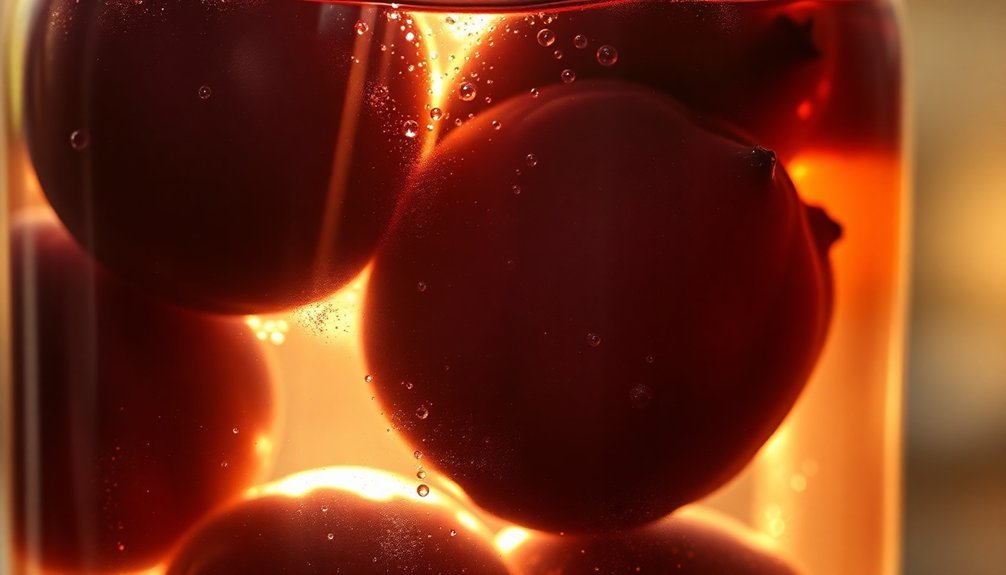
Several critical mistakes can derail your fruit-infused vodka project, turning a potentially delightful spirit into an undrinkable mess. You'll need to be vigilant about proper storage, handling, and monitoring to guarantee your infusion maintains its quality over time.
The most devastating mistakes you'll want to avoid are:
- Not storing your infusion properly – keep it sealed in a cool, dark place and always refrigerate to prevent spoilage.
- Failing to remove fruits at the right time – leaving them too long leads to over-extraction and bitter flavors.
- Using damaged or unclean fruits and equipment – contamination will ruin your entire batch.
- Skipping regular taste tests and monitoring – you won't catch problems early if you're not paying attention.
Don't forget to label your containers with dates and maintain proper sanitization throughout the process.
You'll need to watch for signs of spoilage, such as unusual cloudiness, mold, or off-putting smells.
Remember that different fruits require different infusion times and proportions – harder fruits need longer, while softer ones infuse quickly.
Always use tight-fitting caps to prevent oxygen exposure, which can lead to oxidation and spoilage.
Traditional Russian Vodka Infusions
Russians' practice of infusing vodka goes back centuries, reflecting a rich cultural heritage where each household crafted its own unique flavors.
You'll find that traditional Russian infusion methods involve carefully selecting local ingredients like fruits, herbs, and spices, then letting them steep in vodka for extended periods in cool, dark places.
The artisanal process hasn't changed much since the 18th century, as Russians continue to honor these time-tested techniques for both celebratory and medicinal purposes.
Cultural Heritage Connections
The rich tapestry of Russian cultural heritage interweaves deeply with vodka infusions, a tradition that spans centuries of the nation's history. You'll find that these infusions aren't just about flavoring spirits – they're a living connection to Russia's past, where each family and landowner took pride in creating their unique recipes.
When you explore Russian cultural celebrations, you'll discover that flavored vodkas play a central role in marking life's significant moments:
- Weddings feature specially prepared infusions that symbolize the union's sweetness.
- Birth celebrations often include traditional fruit-based vodkas passed down through generations.
- Departure ceremonies incorporate specific flavored vodkas to wish travelers good fortune.
- Funeral gatherings honor the deceased with ceremonial vodka offerings.
You'll notice that these infusions reflect regional diversity and seasonal abundance, with each area of Russia developing its distinctive flavors.
The practice of keeping fruit in vodka isn't just about preservation – it's about maintaining a cultural legacy that's documented in literature, celebrated in folklore, and practiced in homes across the country.
It's a tradition that continues to evolve while honoring its historical roots.
Artisanal Infusion Methods
Traditional Russian vodka infusion methods showcase a precise balance of ingredients and timing, creating complex flavor profiles that have been perfected over generations.
You'll find that the basic ratio follows a consistent rule: one cup of ingredients per liter of vodka, guaranteeing ideal flavor extraction without overwhelming the spirit.
When you're crafting these infusions, you'll need to carefully prepare your chosen ingredients by chopping them into small pieces.
Whether you're working with spicy peppers for a traditional Pertsovka or combining fruits with aromatic spices, proper sizing guarantees even flavor distribution.
You'll want to seal your mixture in a clean jar and store it in a cool, dark place, remembering to shake it daily to enhance the infusion process.
Your timing will vary depending on your ingredients. If you're making a spicy infusion, you'll need just 3-5 days, while delicate fruit combinations might require up to a month.
Once your infusion is complete, strain it through a fine mesh strainer or cheesecloth to remove all solids.
The resulting infused vodka can be stored indefinitely in your freezer, ready to be served chilled in the traditional Russian style.
Modern Culinary Applications
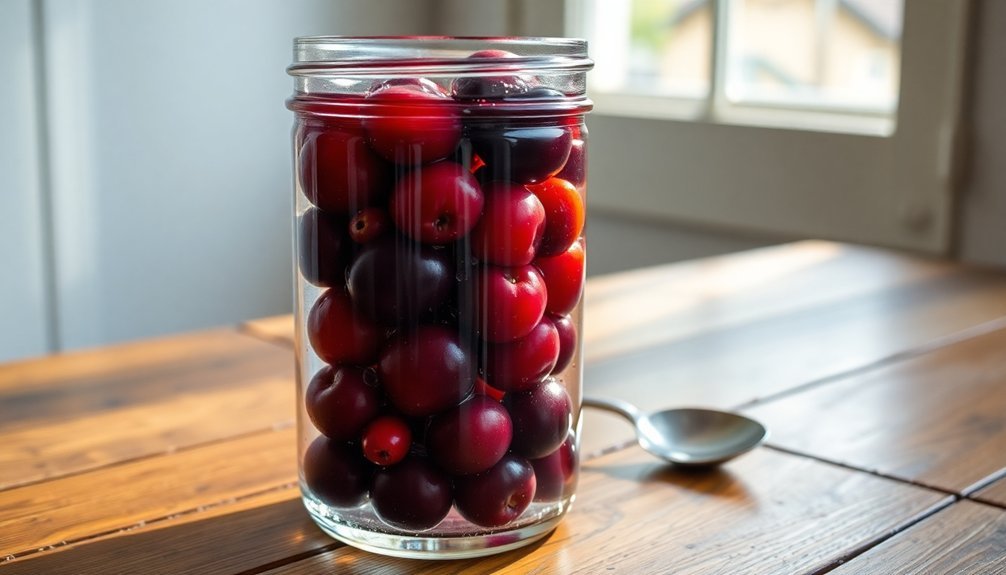
Modern culinary enthusiasts have revolutionized vodka infusions by incorporating diverse spices and innovative ingredients while respecting time-honored methods. You'll find today's vodka infusions ranging from traditional pepper varieties to experimental combinations that push culinary boundaries.
While Russians traditionally consume vodka neat with zakuski, you can now explore these exciting modern applications:
- Create custom heat levels by combining different pepper varieties, from mild bell peppers to scorching hot chilis.
- Develop unique flavor profiles using combinations of allspice berries, black peppercorns, and aromatic spices.
- Incorporate seasonal fruits and herbs for limited-edition infusions that complement specific dishes.
- Design signature infusions that pair perfectly with both traditional zakuski and contemporary cuisine.
You don't need to limit yourself to traditional recipes – modern culinary applications encourage experimentation while maintaining vodka's essential character.
Whether you're serving it ice-cold in shot glasses or incorporating it into sophisticated dishes, today's vodka infusions offer versatility that bridges traditional Russian hospitality with contemporary tastes.
The key is maintaining the balance between innovation and respect for the spirit's cultural significance, ensuring each infusion enhances rather than overwhelms the vodka's natural qualities.
Storage and Aging Guidelines
Proper storage and aging practices build upon these modern culinary applications to guarantee your vodka infusions reach their full potential.
Once you've created your infusion, you'll want to store it in the freezer, which helps maintain its flavor and strength while preventing dilution. For traditional Russian consumption, both your vodka and serving glasses should remain freezer-chilled until you're ready to serve.
Before storing your infused vodka, it's vital to understand the resting process known as assimilyatsia. You'll need to let your mixture rest for 5-6 hours to several days, allowing the ingredients to fully integrate and develop a smooth, consistent taste. During this period, you can verify the alcohol content and check for any impurities.
To ensure the highest quality, you'll want to filter your infusion through activated charcoal columns, preferably made from birch wood. This important step removes impurities and enhances the taste.
If you're using particularly mineral-rich water, you can skip the reverse osmosis purification. Remember to regularly check your filtered vodka's oxidizability and alcohol content to maintain consistent quality throughout the storage period.
Frequently Asked Questions
Can Children Eat Fruit Preserved in Vodka if Used in Desserts?
You shouldn't serve vodka-infused fruit to children, even in desserts. The alcohol doesn't completely cook off, and it's unsafe for kids. It's best to use non-alcoholic alternatives for family-friendly treats.
Does the Alcohol Content Decrease Over Time During the Preservation Process?
You'll find that alcohol content remains stable if you store the infusion properly. It only decreases considerably if you heat or cook the mixture, but proper storage in a cool, dark place maintains potency.
Can Homemade Vodka-Preserved Fruit Be Legally Sold or Gifted?
You'll need proper licensing to sell vodka-preserved fruit legally. While you can gift it to friends, make sure you're following local liquor laws and inform recipients about storage guidelines and safety precautions.
What Happens if You Mix Different Types of Alcohol Instead of Vodka?
When you mix different types of alcohol, you won't face any special risks beyond the total amount of alcohol consumed. It's the quantity and speed of drinking, not the mixing itself, that affects you most.
Is It Safe to Preserve Fruit in Plastic Containers Instead of Glass?
You shouldn't preserve fruit in plastic containers as they can leach chemicals into your alcohol. Stick to glass containers – they're safer, easier to sterilize, and won't affect the flavor of your infusion.
In Summary
You've now learned the rich tradition of Russian fruit-infused vodka, from its practical preservation roots to modern culinary delights. Whether you're making traditional nalivka or experimenting with your own infusions, remember to select quality ingredients and follow proper storage guidelines. This centuries-old practice isn't just about preservation—it's about creating unique flavors while honoring a cherished part of Russian culture.

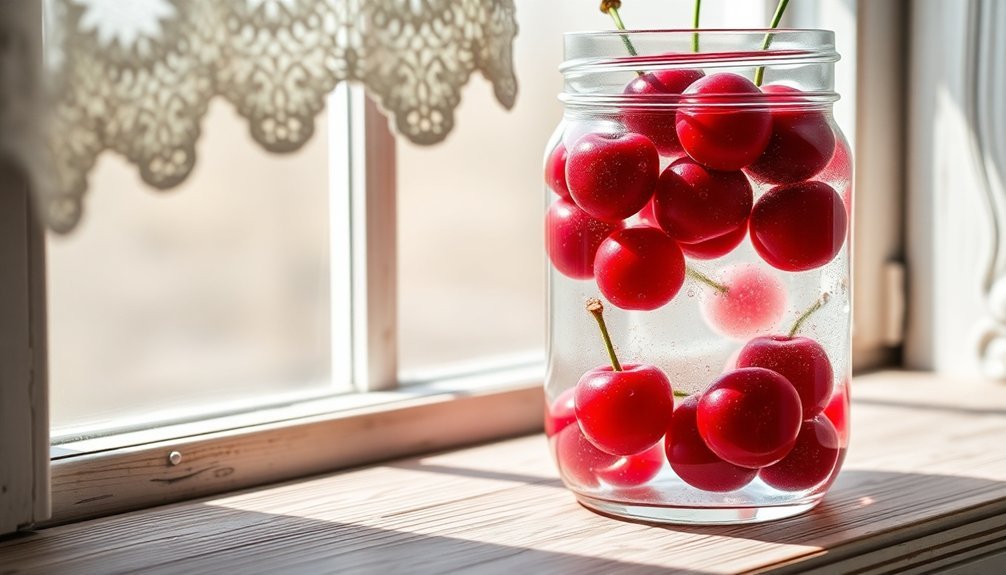



Leave a Reply